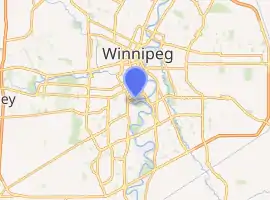BDI Bridge
The Elm Park Bridge, sometimes locally referred to as The BDI Bridge or The Ice Cream Bridge, is a bridge across the Red River in Winnipeg, Manitoba. The bridge links Kingston Crescent in St. Vital with the Jubilee/Osborne area, a Winnipeg community across the Red River. The BDI Bridge nickname is derived from the nearby Bridge Drive-In (BDI), a popular ice cream vendor. The BDI itself is so-named because of its proximity to the Elm Park Bridge. It was built in 1912 and it was open to two-way vehicular traffic. The deck of the bridge is only 15 feet wide but even the large cars of the early 1960s passed each other. In 1974, it was closed to vehicular traffic, and is a common bridge for foot traffic to the BDI in summer.
Elm Park Bridge BDI Bridge | |
|---|---|
| Coordinates | 49.8543°N 97.1420°W |
| Carries | Pedestrians, bicycles. |
| Crosses | Red River |
| Locale | Fort Rouge <> St. Vital |
| Preceded by | St. Vital Bridge |
| Followed by | Fort Garry Bridge |
| Characteristics | |
| Design | Truss |
| Material | Steel |
| Width | 15 feet (4.6 m) |
| No. of spans | 1 |
| History | |
| Contracted lead designer | E. E. Brydone-Jack |
| Constructed by | Elm Park Bridge Company |
| Construction start | 1912 |
| Opened | 1913 |
| Replaces | Pontoon Bridge |
| Location | |

| |
History
The current Elm Park Bridge was first built as a toll bridge to replace an 1890s pontoon bridge of the same name,[1] that gave pedestrians access to Kingston Row.
R. F. McWilliams, owner of Elm Park, had tried on numerous occasions to have the City of Winnipeg pay for the construction of a better bridge across the Red River between Jubilee and St. Vital.[2] A full page ad in the Winnipeg Free Press in May 1912 had a diagram showing the Bridge with the Park Line Loop ending on the Jubilee side of the Red River and advertising "Five minute [street]car service to the city".[3] The December 1912 RM of St. Vital council meeting had passed a motion saying that they preferred[4] the bridge to be located closer to Pembina Street (now Pembina Hwy.). The City of Winnipeg "opened" the section of Jubilee so that the streetcar could terminate at the new Elm Park Bridge.[5]
The toll was 5 cents for pedestrians, 10 cents for cars, and 25 cents for trucks. A repair project that involved replacing the wood under asphalt closed the Bridge during the summer of 1946. The wood for the project came from the cordite plant in Transcona. Two layers of asphalt were then poured over the wood.[6] The tolls were removed in 1946.
In 1974 vehicle traffic was no longer allowed on the bridge.[7] Facing heavy renovation costs for the bridge in the mid-90s, the city investigated the possibility of tearing it down but backed away when told of the $1,000,000 price tag, and thus instead was fixed at the cost of $300,000.
On May 24, 2014, a 100th anniversary of the bridge was held.
The Park Line streetcar route provided access between Elm Park and downtown Winnipeg via the Elm Park bridge.
References
- "Up and Down the Red". Winnipeg Free Press. July 15, 1891. p. 8.
- "Elm Park Bridge". Winnipeg Free Press. November 13, 1912. p. 15.
- "Two Direct Roads Lead To Elm Park". Winnipeg Free Press. May 4, 1912. p. 13.
- "Want Elm Park Bridge Moved". Winnipeg Free Press. December 28, 1912. p. 10.
- "New Street To Elm Park Bridge". Winnipeg Free Press. September 19, 1912. p. 16.
- "Elm Park Bridge Open". The Winnipeg Tribune. October 1, 1946. p. 16.
- Bidwell, Frances (March 20, 1974). "Govt. Will Share Costs of Projects". Winnipeg Free Press. pp. 1, 4.